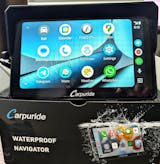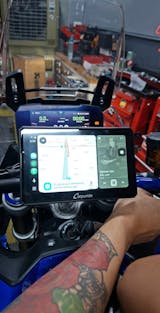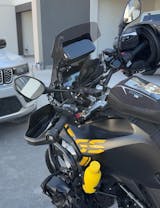Riding a motorcycle in extreme heat can be risky for both you and your bike. High temperatures increase the chances of dehydration, fatigue, and mechanical issues. To stay safe and comfortable, you need to know how to handle the heat effectively. This guide will show you how to protect yourself and your motorcycle when riding in extreme conditions.
How Hot is Too Hot to Ride a Motorcycle?
When temperatures surpass 95°F (35°C), riding becomes a real challenge. Not only does your body struggle to cool down, but the heat radiating off the asphalt can exceed 140°F (60°C). This can make the environment feel even hotter, causing heat stress, dizziness, and discomfort. On top of that, the scorching pavement impacts your tires, reducing grip, and may also cause the engine to overheat, making your bike work harder.
Riding through this kind of heat can feel suffocating, especially in places like Arizona or Southern California, where summer temperatures regularly soar above 100°F.

Effects of Extreme Heat on You and Your Motorcycle
For You
Dehydration
In extreme heat, your body loses fluids quickly, leading to dehydration. This can result in fatigue, headaches, and dizziness.
Heat Exhaustion
When your body overheats, you may feel weak, nauseous, or disoriented. Without proper cooling and hydration, heat exhaustion can escalate to heat stroke.
Slower Reaction Times
Extreme heat can dull your senses and slow your reaction time, making it harder to stay alert on the road.
Sunburn and Skin Damage
Riding in direct sunlight without proper protection can lead to painful sunburns and long-term skin damage.
For Your Motorcycle
Overheating Engine
The engine has to work harder to stay cool, increasing the risk of overheating. This can lead to reduced power or even mechanical failure.
Tire Pressure Issues
Extreme heat causes tire pressure to rise, affecting grip and handling. Over-inflated tires can make your ride unstable.
Oil and Fluid Breakdown
The heat accelerates the breakdown of oil and coolant, which can lead to faster engine wear and reduced lubrication, potentially damaging critical parts.
Battery Stress
High temperatures can strain your motorcycle’s battery, reducing its overall lifespan and possibly causing it to lose charge more quickly during your ride.
Essential Tips for Riding in Extreme Heat
Besides staying hydrated and wearing the right gear, having a good motorcycle radio can keep you entertained and alert on long rides. Listening to traffic updates or weather conditions can help you avoid congested and heat-intensive areas.
For the Rider: How to Stay Safe and Comfortable
Stay Hydrated
When riding in extreme heat, hydration is crucial. Carry water or an electrolyte drink like Gatorade or Powerade to stay refreshed and maintain your energy. Regular sips will prevent dehydration, even before you feel thirsty.
Take Frequent Breaks
Plan regular stops to cool off and refuel at places with shade or air conditioning. Your motorcycle CarPlay system can help you find nearby rest stops and plan smarter routes, making your ride smoother and more comfortable.
Wear Protective Gear
Choose lightweight, ventilated gear that protects you from the sun without trapping heat. Light-colored jackets and helmets with built-in ventilation will help reflect sunlight and keep you cooler.
Use Sunscreen and UV Protection
Exposed skin can burn quickly on long rides. Apply sunscreen with an SPF of at least 30, and wear UV-protective sunglasses to shield your eyes from the sun’s glare.
Stay Connected and Informed on the Road Using Apple CarPlay for motorcycles allows you to access your maps, music, and messages hands-free, ensuring that you stay connected without compromising your safety on the road, especially in extreme weather conditions.

For Your Motorcycle: Protecting Your Bike in Hot Weather
Check Tire Pressure Regularly
Extreme heat causes tire pressure to rise, which can affect your grip and control. Check your tire pressure before and during your ride using a portable gauge, and ensure it’s within the recommended range.
Monitor Essential Bike Metrics
Keep an eye on crucial factors like tire pressure, oil levels, and coolant levels. These components are more vulnerable in extreme heat, and regular monitoring can help prevent overheating, blowouts, or mechanical issues during your ride.
Use High-Quality Fluids
Heat breaks down fluids faster. Use high-quality oil and coolant designed for extreme temperatures to ensure your engine stays lubricated and cool during hot weather.
Park in the Shade
Whenever possible, park your motorcycle in shaded areas or use a cover. This prevents the bike from overheating while parked and protects components like the seat and electronics from excessive heat damage.
Utilize Weather and Traffic Alerts
Stay updated on traffic and weather conditions through your CarPlay or Android Auto system. This will help you avoid congested, heat-intensive routes and ensure your ride is smoother and safer.
Conclusion: Stay Cool and Ride Safely
Always follow motorcycle safety tips when riding in extreme heat. Riding a motorcycle in extreme heat can be challenging, but with the right precautions for both you and your bike, you can stay safe and comfortable. Equip yourself with the best tools for a smooth ride—consider upgrading to a Motorcycle CarPlay Screen from Carpuride to enhance your navigation and make your journey even easier.
FAQs
What Should I Do If I Feel Dizzy While Riding in Extreme Heat?
If you start feeling dizzy or lightheaded, it's crucial to pull over immediately and find a shaded or cool area. Hydrate with water or an electrolyte drink, and give yourself time to cool down before continuing. Ignoring these signs can lead to heat exhaustion or even heat stroke.
How Often Should I Take Breaks When Riding in Extreme Heat?
It's recommended to take a break every 45 minutes to an hour in extreme heat. This helps you cool down, hydrate, and recharge. Finding shaded areas or air-conditioned stops will help keep your body temperature under control and prevent heat-related illnesses.
What Gear is Best for Riding in Extreme Heat?
Use ventilated, lightweight gear like mesh jackets and moisture-wicking underlayers to keep air circulating around your body. Consider accessories like cooling vests or neck wraps to lower your core temperature during long rides.
Is it Better to Ride Early in the Morning or Late at Night in Extreme Heat?
Riding early in the morning is usually better because temperatures are cooler, and you avoid the intense afternoon sun. Night riding can be more challenging due to lower visibility and increased wildlife activity, which can be risky.
How often Should I Check my Motorcycle’s Tire Pressure in Hot Weather?
Check tire pressure before starting your ride and during breaks, as heat can cause the pressure to rise. Proper tire pressure is essential for maintaining grip and control on the road, especially when the asphalt is extremely hot.
Related Reading:
Upgrade Your Car! Best Portable CarPlay and Android Auto Display in 2024
Is Apple CarPlay Worth It for Older Cars? Here's the Final Answer
Do I Need to Tape My Motorcycle Air Filter? Here's What You Need
Best 10 MotorCycle Upgrades and Modifications You Should Try















